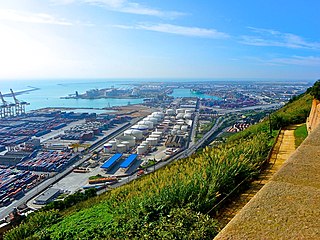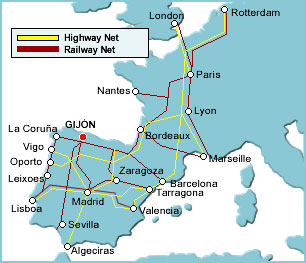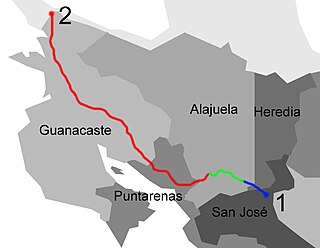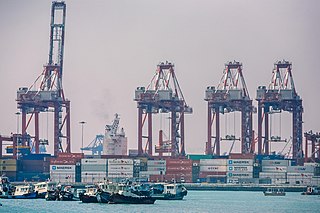
There are many modes of transport in Costa Rica but the country's infrastructure has suffered from a lack of maintenance and new investment. There is an extensive road system of more than 30,000 kilometers, although much of it is in disrepair; this also applies to ports, railways and water delivery systems. According to a 2016 U.S. government report, investment from China that attempted to improve the infrastructure found the "projects stalled by bureaucratic and legal concerns".

Puerto Cortés, originally known as Puerto de Caballos, is a port city and municipality on the north Caribbean coast of Honduras, right on the Laguna de Alvarado, north of San Pedro Sula and east of Omoa, with a natural bay. The present city was founded in the early colonial period. It grew rapidly in the twentieth century, thanks to the then railroad, and banana production. In terms of volume of traffic the seaport is the largest in Central America and the 36th largest in the world. The city of Puerto Cortés has a population of 73,150.

Limón is one of seven provinces in Costa Rica. The province covers an area of 9,189 km2, and has a population of 386,862.

Limón, commonly known as Puerto Limón, is a district, the capital city and main hub of Limón Province, as well as of the Limón canton in Costa Rica. It is the seventh largest city in Costa Rica, with a population of over 94,000, and is home to the Afro-Costa Rican community. Part of the community traces its roots to Italian, Jamaican and Chinese laborers who worked on a late nineteenth-century railroad project that connected San José to Puerto Limón. Until 1948, the Costa Rican government did not recognize Afro-Caribbean people as citizens and restricted their movement outside Limón province. As a result of this travel ban, this Afro-Caribbean population became firmly established in the region, which influenced decisions not to move even after it was legally permitted. Nowadays, there is a significant outflow of Limón natives who move to the country's Central Valley in search of better employment and education. The Afro-Caribbean community speaks Spanish and Limonese Creole, a creole of English.

Puntarenas is a city in the Puntarenas Province, on the Pacific coast of Costa Rica. As the seat of the Municipality of Puntarenas canton, it is awarded the title of city, which comprises the Puntarenas, Chacarita and El Roble districts. As the city of the first canton of the province, it is the capital city of the Puntarenas Province as well, according to the Administrative divisions of Costa Rica.

The Port of San Juan is a large seaport facility in and around San Juan Bay in Puerto Rico. Primarily located within the capital municipality of San Juan, the Port of San Juan consists of multiple public and private passenger and cargo facilities. Public facilities are administered by the Puerto Rico Ports Authority (PRPA), under the Department of Transportation and Public Works of Puerto Rico.

The Port of Barcelona is a major port in Barcelona, Catalonia, Spain. Its 7.86 km2 (3 sq mi) are divided into three zones: Port Vell, the commercial/industrial port, and the logistics port. The port is managed by the Port Authority of Barcelona, itself owned by the state-owned Ports of the State.

Rail transport in Costa Rica is primarily under the stewardship of Incofer, an autonomous institution of the state. Incofer owns the national railway infrastructure and operates virtually all freight and passenger services, which consist primarily of commuter trains through the highly populated Central Valley. The whole Incofer network is 1,067 mm narrow gauge, although there are small tourist railways of other gauges.

El Musel is a seaport located in the north of Spain in Asturias, and in the middle point of the Cantabrian Sea coast, it is the Port of Gijón as a gateway to Europe through the A-66 and A-8 highways, allowing direct access to the west and centre of the Iberian Peninsula.

Esparza is a canton in the Puntarenas province of Costa Rica. The head city is Esparza in Espíritu Santo district.
The Port Terminal of Limón,, whose official name is Hernán Garrón Salazar Terminal, adjacent to the city of Limón, is one of the seaports in the Caribbean coast of Costa Rica.

El Port of Puerto Plata is found in San Felipe de Puerto Plata, in Dominican Republic. This is the main port on the north coast and is currently used for cargo operations. In December 2021, the new Taino Bay tourist and cargo terminal was inaugurated.

National Primary Route 32, or just Route 32 is a National Road Route of Costa Rica, located in the San José, Heredia, Limón provinces. It connects the central valley and Greater Metropolitan Area to the Caribbean coast of the country.
National Secondary Route 257 is an arterial road from Route 32 to the Moín Container Terminal in the Caribbean sea of Costa Rica.

National Primary Route 27, or just Route 27 is a National Road Route of Costa Rica, is a route which connects the Greater Metropolitan Area to Caldera Port and the Pacific coast of the country.
The Moín Container Terminal, officially known in Spanish as Terminal de Contenedores de Moín is a container port in the Limón province of Costa Rica. Not to be confused with the Port of Moín, operated by JAPDEVA.
The Port Terminal of Moín,, whose official name is Gastón Kogan Kogan Terminal, is located in the Moín bay, west to the city of Limón, is one of the seaports in the Caribbean coast of Costa Rica. Not to be confused with the Moín Container Terminal operated by APM Terminals.

National Primary Route 1, formally known as Carretera Interamericana Norte, is the northern segment of the Pan-American Highway that traverses Costa Rica.

The port of Marín and Ria de Pontevedra is located in the municipalities of Marín and Pontevedra, Galicia (Spain). It is on the southern shore of the Ria de Pontevedra.

The Port of Callao, officially the Callao Port Terminal, is a maritime port on the central coast of Peru, in the south-eastern Pacific, located in Callao. It is also the de facto port of the city of Lima.


















